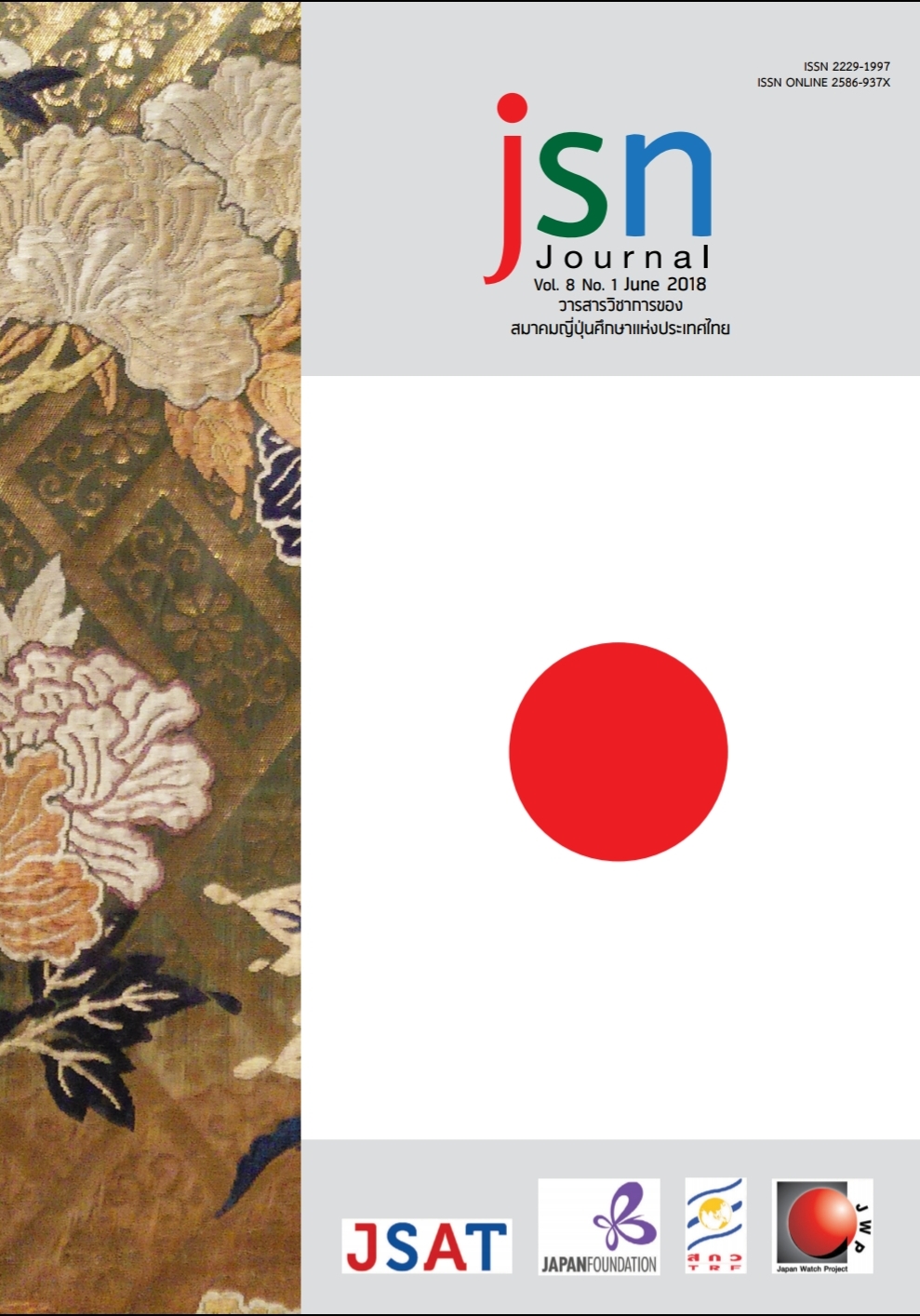Changing of Women Status of Women in Ooku in Edo Periods
Main Article Content
Abstract
Article Details
ข้อความและข้อคิดเห็นต่างๆ ในบทความเป็นของผู้เขียนบทความนั้นๆ ไม่ใช่ความเห็นของกองบรรณาธิการหรือของวารสาร jsn Journal
References
Anne Walthall (2001).「江戸文化における大奥」『ジェンダー研究』21, 43-64.
青木京子(2008).「松本清張「大奥婦女記」論「趣味史談大奥秘史」との比較を中 心として」 『阪神近代文学研究』6, 63-73.
安藤雄一郎 (2011).『歴史を動かした徳川十五代の妻たち』.東京:青春出版社.
_____ (2017).『大奥の女たちの明治維新』.東京:朝日新聞出版.
井沢元彦(2007).「冬ではなく夏だったら大奥最大のスキャンダル「絵島生島事件」はなかっ た!?」.『逆説の日本史(第700回)第71話徳川幕閣の展開と改革1』190, 152-155.
石田俊 (2013).「綱吉政権期の江戸城大奥―公家出身女中を中心に」『総合女性史研究』30, 4-24.
岩城紀子(1998).「「絵双六」に見る町娘と大奥―江戸女性の“あこがれ”」『歴史 読本』6, 248-253.
エディキューブ(編).(2012).『大奥のすべて』.東京:双葉社.
久保貴子 (2011).「天皇の後宮と大奥のつながり」『歴史読本』3, 148-153.
小石房子 (1999).「大奥女戦争」『歴史と旅』12, 120-149.
島津隆子(2005).「大奥の組織と実力者たち」『歴史読本』50, 144-149.
清水昇・川口素生 (2007).『大奥―女たちの暮らしと権力闘争』.東京:新紀元社.
具知會(2011).「大奥の老女の性格―政治的な活動を中心として」『お茶の水女子 大学比較日本学教育研究センター』3, 159-161.
諏訪春雄 (1998).「「偐紫田舎源氏」大奥モデル説の謎」『真相探究』6, 180-185.
鈴木賢次(2011).「信長・秀吉の奥と将軍の大奥」.『特別企画;大奥研究最前 線』3, 140-147.
鈴木由紀子(2011).「江と春日局の対立はあったのか」『特別企画;大奥研究最前線』3, 154-158.
宝島編集部(編)(2012).『大奥のヒミツ』.東京:宝島社.
竹内誠 (2007).「「田沼時代」に見る、大奥老女の政治力」.『東京人』7, 70-73.
竹内誠・深井雅海・松尾美恵子(編)(2015).『徳川「大奥」事典』.東京:東京堂出版.
特集入門講座(2004a).「Q&A江戸城大奥の全てー第4章―江戸城の表と奥」『歴史読本』2, 52-55.
_____ (2004b).「Q&A江戸城大奥の全てー第3章―奉公に上がる」『歴史読本』49(2), 56-59.
卜部典子 (2008).「大奥関係人物事典」『歴史読本』53, 215-232.
松尾美恵子 (1998).「「女中分限帳」が語る大奥」『歴史読本』特集史料, 192-201.
_____ (2008).「大奥史料研究最前線―「女中帳」を読む」特別論考7, 208-213.
望月真澄 (2003).「江戸城大奥女性の代参についてー感応寺の事例を中心にー」『身延論叢』5, 119-150.
萩原裕雄(2003).「家継時代―大奥派闘抗争事件」『歴史読本』8, 118-121.
畑尚子(2009a).「奥向の贈答における菓子の役割―将軍の息子と江戸城大奥との関係を中心に」 『和菓子』3, 14-38.
畑尚子(2009b).『幕末の大奥』(第6刷発行).東京:岩波書店.
_____ (2009b).『徳川政権下の大奥と奥女中』.東京:岩波書店.
_____(2011).「江戸城大奥の基礎はいつ作られたのか」『特別企画:大奥研究 最前線』3, 127-138
_____ (2012).『大奥お年寄瀧山日記』.5月206号:国史学会(編), 101-135.
原田伴彦・百瀬明治・遠藤武(2006).『絵で見る江戸の女たち』.東京:柏書房.
山本博文 (2005).「幕府大奥と薩摩藩奥の交際についてー「薩摩藩奥女中文書」の考察」 『東京大学史料編纂所研究紀要』15, 113-131.
_____(2004).「「人事」の日本史第42回近世編ー大奥女中の出世競争『エコ ノミスト』44, 42-43.
_____(2007).「江戸大奥いじめ物語ー“お局さま”は新人転がしが大好き」『婦人公論』92, 52-54.
_____ (2007).『将軍と大奥ー江戸城の「事件と暮らし」』.東京:小学館.
_____ (2012).『図説ー大奥の世界』.東京:河出書房.
湯 麗 (2011).「日本女性地位の歴史的考察『全国民事慣例類集』からみる近世後期女性の婚姻地位 」 『日中学者の思考』2, 94-109.
慶幹進士 (1980).「室町殿の大奥・江戸城の大奥」『国文学』13, 187-192.


